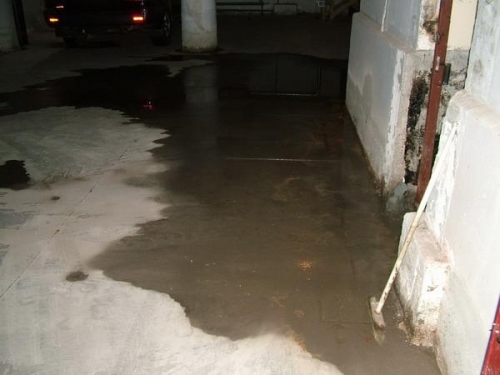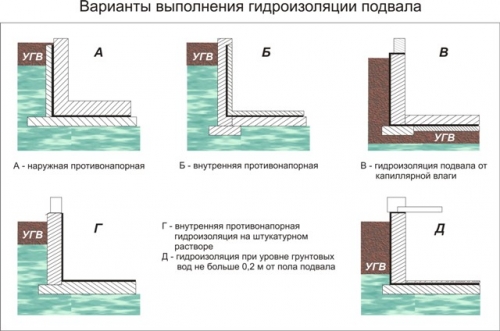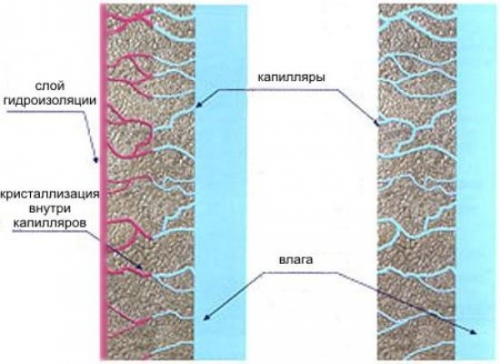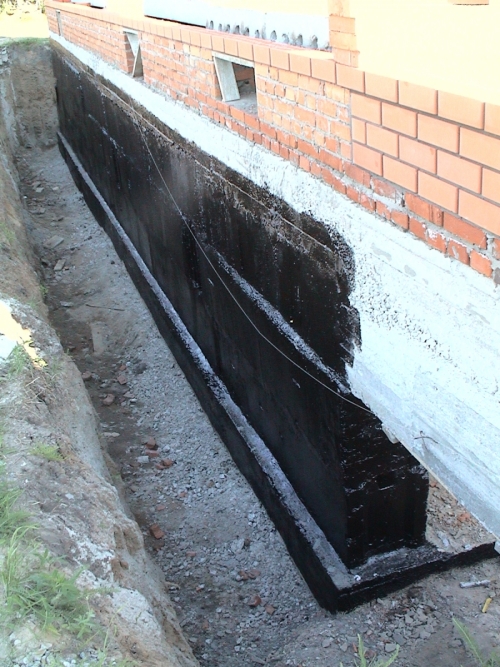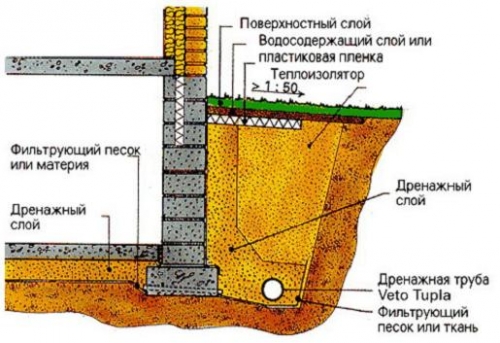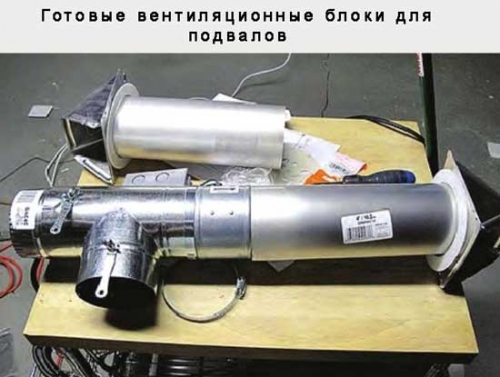To protect the door from hacking and attackers, the ideal option would be to install ...
|
|
Granite a symbol of hardness and unshakability. Natural stone unites in ... |
In modern private construction, the rafter system of the attic roof gives ... |
Water in the basement. Instructions for eliminating flooding and prevention
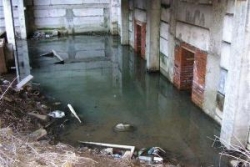
The basement plays an important role for each homeowner, and it doesn’t matter where it is located: under the house, garage or household construction. It serves perfectly for storing things, winter blanks. If this is a spacious room, then they often organize a workshop in it. Sometimes development is carried out by an economical option or with a violation of technology, as a result of which moisture appears in the basement. It gradually destroys the structure, creates the optimal conditions for the formation of mold. Aspergill (moldy mushroom) not only takes an active part in corruption of surfaces, but also affects negatively on human health. The article will talk about protecting the basement from water.
Content:
- Where does the water come from in the basement
- Types of waterproofing of the basement
- Materials for waterproofing basement from groundwater
- Water in the basement what to do?
Where does the water come from in the basement
The fight against destructive force begins with the identification of the cause of its occurrence. Having established the source of trouble, we can talk about the disappearance of moisture in the room. Experts distinguish 3 factors of dampness.
- The penetration of groundwater into the basement. In this case, flooding occurs due to an error in a geodetic study or incorrect reading it. It is worth noting that many owners of the site abandon the survey work, acting on the principle of the neighbors everything is fine, which means that I will have the same.
- The penetration of rain and melt water is the most common reason. The missing or incorrectly equipped drain and drainage system enables the waters to accumulate at the foundation, and then penetrate the basement.
- Emergency state of plumbing pipes. The most easily assured origin of moisture.
The probability of flooding the basement should be calculated even at the construction stage, here it is necessary to make every effort to prevent. In the course of the work, the relief of the site, the level of groundwater, depth of the basement, etc. are taken into account. It should be remembered that a person cannot influence nature, therefore, it is not worth saving.
It is possible to avoid moisture formation in the basement through timely organization of reliable waterproofing and drainage systems. However, there are situations when the house is acquired and this problem is already revealed during operation. Then labor -intensive and expensive measures are performed to eliminate water in the basement and prevent its re -appearance.
Types of waterproofing of the basement
Of course, today the market offers many materials, each of which is appropriate in its place. Before going to a construction store, you need to know that 3 types of waterproofing are distinguished:
- Anti -nap. Such waterproofing is carried out for groundwater, located above the point of the floor location. It is used only from the outside. Here we need materials opposing the positive pressure of water.
- Underwear.This waterproofing provides for the protection of the basement from the penetration of melt and rainwater. It is mainly necessary if underground waters lie deeply and there is a low probability of raising them.
- Anticapillary. The arrangement of such a system is used as the protection of dense and porous concrete, brick structures from destruction. Previously, for this purpose, bitumen materials were used, today they give preference to penetrating compositions.
Materials for waterproofing basement from groundwater
For work, various materials can be used, which are conditionally divided according to the principle of application:
- rolledor leaf materials on bitumen or polymer -based based on surfaces in several layers. These include: roofing material, hydrobiles, glass insulus and others. Before applying the surface, they are aligned, dried and treated with bitumen emulsion. For greater reliability, it is recommended to lay out a clamping wall of brick or concrete blocks with a 120 mm wide. The formed gap between it and waterproofing (up to 15 mm) is filled with a pantry;
- penetratingmaterials are used for internal work. They endow the concrete base with properties that do not allow water to penetrate it under certain pressure. It is applied to a wet surface, such an environment creates the conditions under which the composition forms crystals that fill all pores and cracks. You should know that this mixture is used only on concrete surfaces of good quality, where the depth of cracks does not exceed 0.4 mm;
- caps Materials are a rather extensive category, which includes mastic, pastes and other similar compositions. So, bitumen with mineral additives is applied to strong moistened surfaces from the clinker, concrete blocks, natural stone, etc. Such material forms a waterproof elastic film. It is perfectly opposed to the pressure of water, therefore it is used to arrange waterproofing only from the outside of the structure. Often, bituminous materials are used for external protection against pressure waters. They are applied to the walls and floor (before filling it). The surfaces can be made of hollow blocks, concrete, limestone, brick and so on. Polyurethane coatings are also designed to process external surfaces. But here it is necessary to create conditions under which the foundation could ensure good adhesion;
- hydrophobizerslimit the interaction of the surface with water. Such materials are advisable to use in internal work with well -equipped pressure waterproofing.
Water in the basement what to do?
Often, many owners of flooded basements neglect labor -intensive excavation work, wanting to perform waterproofing in a simpler and more economical way. But such events will only lead to a temporary solution to problems.
Qualitative protection of the structure can be provided only by completing the appropriate work outside the room. In the absence of external protection, the water, penetrating through the thickness of the wall and the floor will eventually squeeze out internal isolation.
External protection of the basement from groundwater
- First of all, the excavation of soil is carried out around the entire external perimeter of the basement. The walls are cleaned of pollution. Large cracks are filled with sand-cement mortar. If possible, all surfaces are aligned as much as possible.
- For outdoor work, the bitumen mastic is first used, then roller materials are glued. It is important to ensure that the ends of the material go beyond the walls of at least 20 cm.
- For the same purpose, penetrating waterproofing can be used. The mixture is diluted according to the manufacturer's recommendations indicated on the packaging. Clushes in the solution are unacceptable. The outer corners of the room are processed with a brush. Then the walls are processed with a roller, the layer thickness should be about 1 mm.
- The drying of the surfaces will take at least 2 days, during which time the composition will penetrate into the thickness of the walls by 30-70 cm (depending on the manufacturer). Properly done work will protect the walls from water penetration for a period of 40-50 years.
- There are situations when there is no access to the external walls and the excavation of soil is impossible here (buildings are located close to each other), in this case injection comes to the rescue. In a certain order, holes are drilled in the wall, into which polymer resins, micro -cements or acrylic gels are pumped under pressure.
- The rapid drainage of storm water will provide drainage laid around the perimeter of the structure or basement. Minimize water entering the basement and installation of gutters and rain recreants. A similar system serves for drainage, it is not used as the only protection against moisture in the room. Its use is advisable only in conjunction with other waterproofing work.
- Upon completion of all work, the pit is filled up and the blind area is restored.
Internal protection of the basement from groundwater
- When starting work, you need to get rid of water. It can be scooped up with improvised means, which is very inconvenient, or use the pump. The selection of a drainage pump should be based on the degree of water pollution for pumping water from the basement. If it contains fibrous inclusions, silt and other large particles, then it is better to use a fecal pump. For example, a conventional drainage pump is able to pump out water from a basement with particles of up to 7 mm, then the fecal unit will cope with particles of 50 mm.
- Next, the premises are dried. You can simply ventilate the room or use forced drying using infrared heaters, thermal guns, etc.
- The weakest points of the room are angles. It is recommended to lay them with a waterproofing cord, swelling, it makes problematic places impenetrable.
- It is advisable to pour the floor with concrete again, first the cracks in the old base are closed. A layer of sand or expanded clay with a thickness of 5-10 cm is filled up, any waterproof rolled material is laid on top. After processing with bitumen mastic, the screed is filled with the addition of hydrophobisators and modified fibrovolon, which will give it water resistance. Instead of concreting, you can install lags, and a board floor on them.
- Vertical surfaces are also cleaned of contaminants, all large cracks are sealed with a panting solution. Wall processing with antifungal drugs is necessarily carried out. Bitumen mastic or other similar material is applied on the surface with a roller or brush.
- Much attention should be paid to ventilation. Its work consists in normalizing air humidity in this difficult room. It prevents mold, eliminates the musty, unpleasant smell of dampness.
- Party-exhaust ventilation can be performed in a simplified version. One pipe should be placed in parallel to the wall almost from the gender itself with the output, using the knee, the second is placed under the ceiling, also with access to the street. The external parts of the pipes are protected from melt and rainwater.
If the structure is quite old and due to any circumstances there is no way to carry out all the recommended repair work, then here you can advise the following:
- fill large cracks with a rag and smear with bitumen mastic;
- organize a pit, that is, dig a hole about half a meter deep, must be strengthened by brickwork. Pour the crushed stone of a large fraction with a thickness of about 10 cm to the bottom. Install a drainage pump equipped with an automatic inclusion system. As soon as the water reaches a certain level, the pump pumps it out. The water drain hose, which goes from the pump, is better to arrange as far as possible from the structure.
To save yourself from laborious and rather costly work, to protect things or winter blanks from damage to water, a timely organization of waterproofing will help. In the process of construction, all of the above events can be carried out with great convenience.

